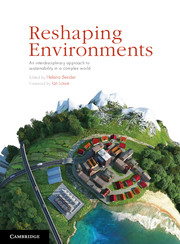Book contents
- Frontmatter
- Contents
- Contributors
- Acknowledgements
- Introduction Reshaping environments – an opportunity for envisioning the future
- Part 1 Cases
- 1 Costa Rica’s dry north-west
- 2 Reshaping land transport in Singapore
- 3 Evaluating different ways of managing forested landscapes
- 4 Changing the landscape management paradigm with farmers
- 5 Meeting development goals without blowing your carbon budget
- 6 The EGLE has landed
- 7 Reshaping the Murray-Darling Basin, Australia
- 8 Burning questions
- Part 2 Skills
- Part 3 Theory
- Index
- Plate Section
- References
2 - Reshaping land transport in Singapore
A policy perspective
from Part 1 - Cases
Published online by Cambridge University Press: 05 February 2013
- Frontmatter
- Contents
- Contributors
- Acknowledgements
- Introduction Reshaping environments – an opportunity for envisioning the future
- Part 1 Cases
- 1 Costa Rica’s dry north-west
- 2 Reshaping land transport in Singapore
- 3 Evaluating different ways of managing forested landscapes
- 4 Changing the landscape management paradigm with farmers
- 5 Meeting development goals without blowing your carbon budget
- 6 The EGLE has landed
- 7 Reshaping the Murray-Darling Basin, Australia
- 8 Burning questions
- Part 2 Skills
- Part 3 Theory
- Index
- Plate Section
- References
Summary
Introduction
Land transport is an important aspect of the urban built environment. The various components of land transport, such as vehicles and infrastructure, are visible elements of cities. Organisations that manage these components, such as public transport agencies and private firms, form the broad institutional nexus underlying the function of cities. Land transport shapes the compactness, efficiency and liveability of cities by influencing location of economic activities and residences, accessibility to services and environmental quality.
Sustainable land transport has been a popular vision in the planning and development of transportation systems in many cities. The Australasian Centre for the Governance and Management of Urban Transport (GAMUT 2006) summarised that in developed countries the main task was to change the mode of land transport from dominance of the private car to public transport. In the developing world, the challenge is to manage motorisation so that fast urbanising countries would not repeat the path of car-dependent transportation in some highly urbanised countries, such as the USA and Australia. Indeed, a land transport system dependent on private cars and highways is no longer feasible given the mounting problems of congestion in cities all over the world, and especially with the peak oil and climate change concerns (GAMUT 2006).
- Type
- Chapter
- Information
- Reshaping EnvironmentsAn Interdisciplinary Approach to Sustainability in a Complex World, pp. 45 - 64Publisher: Cambridge University PressPrint publication year: 2012



